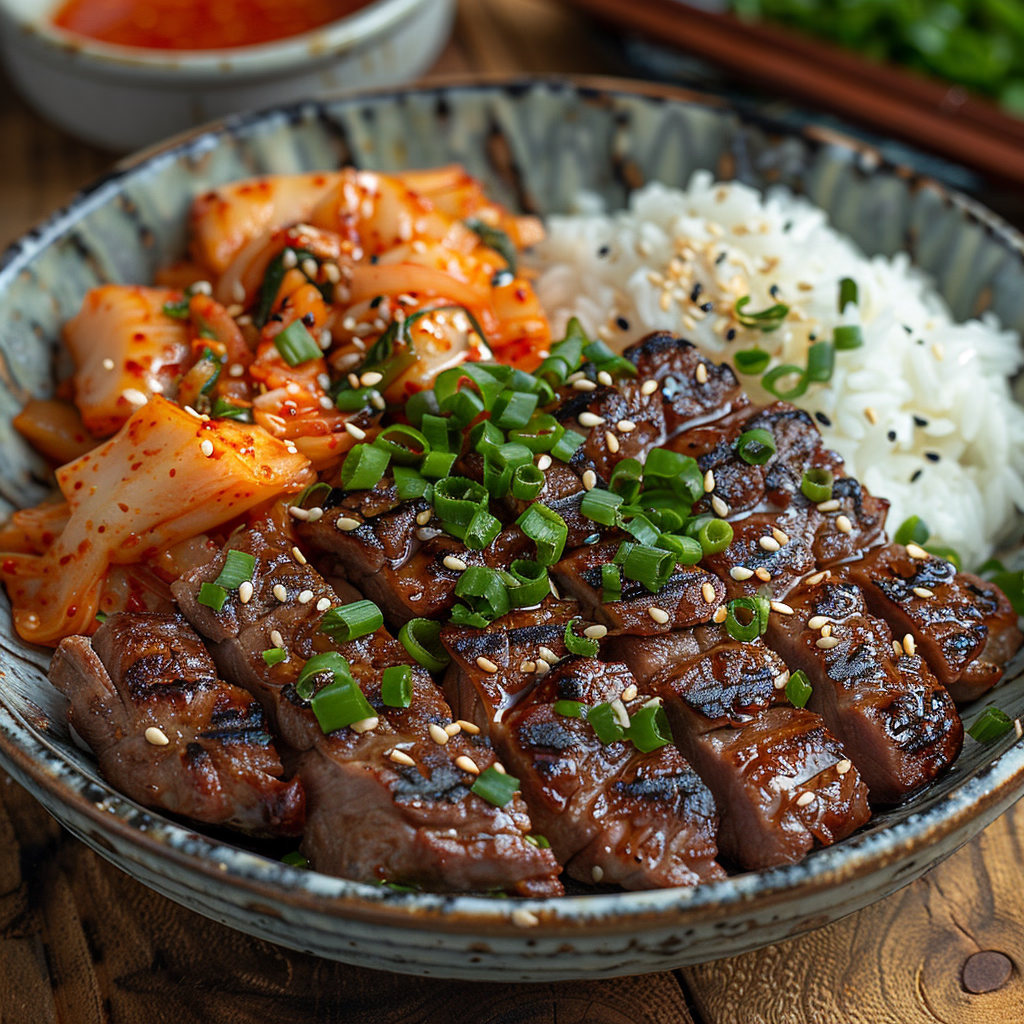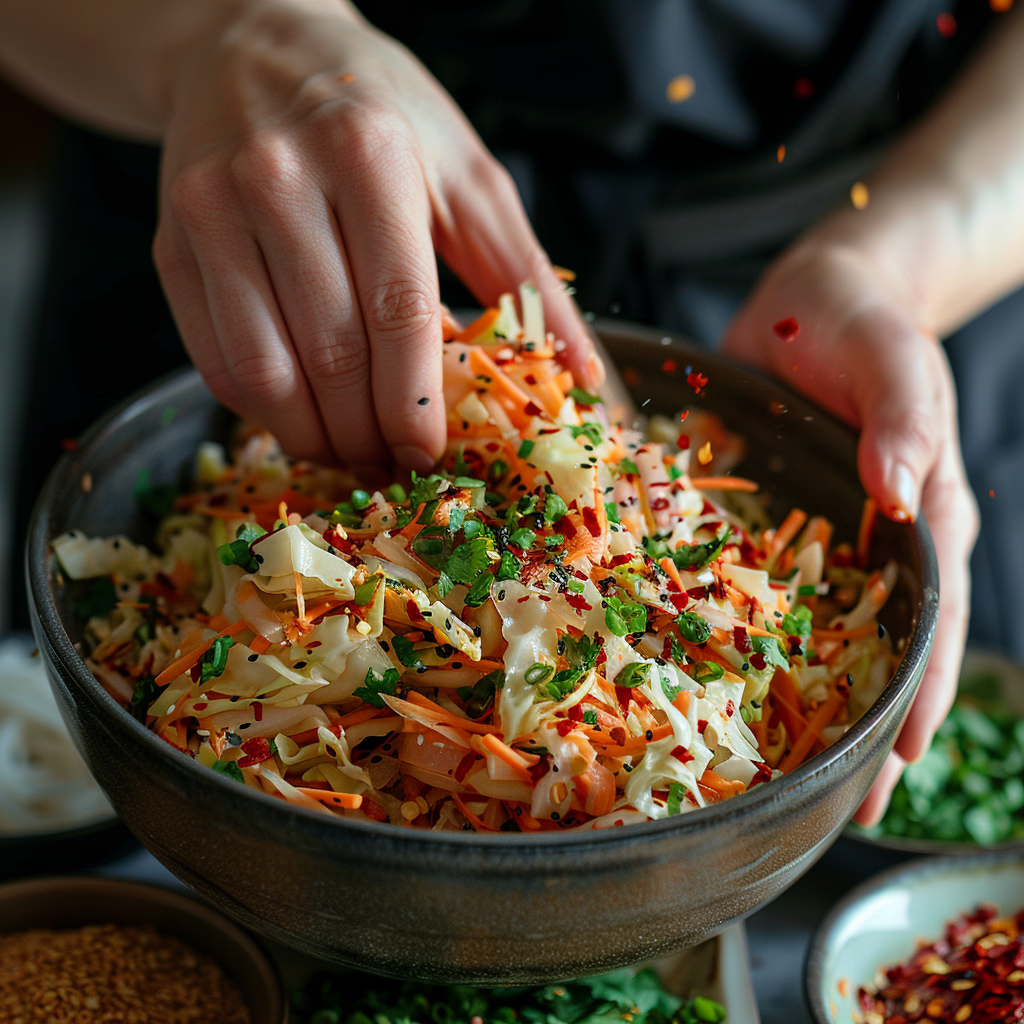Introduction
Kimchi slaw is more than just a side dish; it’s a tantalizing blend of bold flavors and healthful benefits. Rooted in traditional Korean cuisine yet versatile enough for modern meals, this dish offers a delightful fusion of textures and tastes. Whether you’re a foodie exploring new flavors or a health-conscious eater looking to add probiotics to your diet, kimchi slaw has something for everyone. Let’s dive into its rich origins, its exceptional nutritional profile, and how you can bring this unique dish to life in your kitchen.
Part 1: Understanding Fermented slaw
What is Kimchi Slaw?
Kimchi slaw combines the traditional essence of kimchi with the refreshing crunch of slaw. While kimchi is a Korean staple made by fermenting vegetables like napa cabbage with spices, slaw adds a lighter, salad-like texture. Together, they create a dish that’s both tangy and spicy, offering a perfect balance of flavors.
This dish is not only a flavorful addition to meals but also a testament to the versatility of fermented foods. It can stand alone as a side or elevate burgers, tacos, and sandwiches. The unique combination of cabbage and kimchi spices ensures every bite is as nutritious as it is delicious.
The Origins of Kimchi and Its Evolution into Slaw
The roots of kimchi trace back over 3,000 years to ancient Korea, where fermentation became a preservation method during harsh winters. Traditionally, families stored kimchi-filled pots underground, allowing natural fermentation to enhance its flavors.
Over time, global culinary trends inspired new ways to enjoy this ancient dish, including kimchi slaw. By blending fermented flavors with crisp vegetables, chefs and home cooks introduced a lighter, salad-like twist, making it accessible to diverse palates worldwide.
Nutritional Profile of Fermented slaw
Kimchi slaw is a nutrient powerhouse. Packed with probiotics, vitamins, and antioxidants, it supports digestive health, strengthens the immune system, and boosts energy levels. With its low calorie and fat content, it’s a guilt-free indulgence for health-conscious eaters.
By including kimchi slaw in your diet, you’re not just embracing flavor—you’re also supporting overall wellness. It’s no wonder this dish is becoming a global favorite!
Part 2: Health Benefits of Fermented slaw

Probiotic Properties and Gut Health
Kimchi slaw is a rich source of probiotics, beneficial bacteria that support a healthy gut. These microorganisms help improve digestion by breaking down food and enhancing nutrient absorption. Additionally, they promote a balanced microbiome, which is vital for immunity and mental well-being.
Thanks to its fermentation roots, kimchi slaw introduces live cultures into your system. These probiotics may reduce bloating, enhance bowel movements, and even help combat harmful bacteria in your digestive tract. Incorporating it regularly into meals is a flavorful way to improve gut health naturally.
Rich in Vitamins and Minerals
Kimchi slaw isn’t just about probiotics—it’s a treasure trove of essential nutrients. Packed with vitamin C, vitamin A, and B vitamins, it helps maintain skin health, strengthen the immune system, and support energy production. Additionally, the cabbage and carrots provide dietary fiber, promoting a sense of fullness and reducing cholesterol levels.
One notable nutrient in kimchi slaw is vitamin K, essential for bone health and blood clotting. Its antioxidants, such as beta-carotene, combat free radicals, reducing oxidative stress and the risk of chronic diseases.
Potential Anti-Inflammatory Effects
Another remarkable benefit of kimchi slaw is its anti-inflammatory properties. Capsaicin, a compound found in the chili powder (gochugaru) used for kimchi, has been shown to reduce inflammation and even alleviate pain.
Furthermore, the fermentation process produces bioactive compounds that may protect against inflammatory conditions like arthritis and heart disease. Regular consumption of kimchi slaw can be a tasty way to promote long-term health.
Part 3: Making Fermented slaw at Home
Essential Ingredients for Fermented slaw
Creating kimchi slaw at home is both simple and rewarding. The ingredients are widely available, and the preparation allows for customization to suit your palate. Here’s what you’ll need for a classic recipe:
- Napa cabbage or green cabbage (thinly sliced)
- Shredded carrots
- Julienned radishes (optional for extra crunch)
- Thinly sliced scallions
- Minced garlic
- Grated ginger
- Gochugaru (Korean chili powder)
- Fish sauce (or soy sauce for a vegetarian option)
- Rice vinegar
- Sesame oil
- Toasted sesame seeds (for garnish)
Step-by-Step Preparation Guide
Making kimchi slaw involves a few straightforward steps that deliver exceptional flavor and texture. Follow these instructions for the best results:
- Prepare the Vegetables:
Thinly slice the cabbage and rinse it under cold water. Drain thoroughly and place it in a large mixing bowl. Add the shredded carrots, radishes (if using), and scallions for a colorful base. - Make the Dressing:
In a small bowl, whisk together minced garlic, grated ginger, gochugaru, rice vinegar, sesame oil, and fish sauce (or soy sauce). Adjust the amount of chili powder based on your spice tolerance. - Combine and Massage:
Pour the dressing over the vegetables. Using clean hands, gently massage the mixture until the cabbage softens slightly and absorbs the flavors. This step is crucial for achieving the signature texture and taste of Fermented slaw. - Let It Rest:
Cover the bowl and let the slaw sit at room temperature for 15–20 minutes. This allows the flavors to meld beautifully. - Serve and Garnish:
Transfer the Fermented slaw to a serving dish. Sprinkle toasted sesame seeds on top for added crunch and nutty flavor. Enjoy immediately or refrigerate for up to 3 days.
Tips for Customizing Your Fermented slaw
- For a spicier kick, add more gochugaru or a splash of sriracha.
- If you prefer a milder version, reduce the chili powder and increase the sesame oil.
- Experiment with other vegetables like julienned daikon, cucumber, or bell peppers for a fresh twist.
Nutritional Content (Per 100g)
Homemade Fermented slaw isn’t just delicious—it’s also a fun, creative way to enjoy a taste of Korean-inspired cuisine.
Part 4: Culinary Uses of Fermented slaw
Pairing Kimchi Slaw with Various Dishes
Fermented slaw is a versatile addition to countless dishes, adding a zesty kick and a crunch to meals. Its bold flavors pair perfectly with grilled meats, such as chicken, beef, or fish, elevating their savory profiles. Likewise, it complements fried or roasted tofu for a vegetarian-friendly option.
Incorporating Fermented slaw into tacos is another popular choice. The combination of spicy slaw and tender fillings like pulled pork, chicken, or roasted vegetables creates a harmonious burst of flavor. You can also serve it as a refreshing side with rice bowls, noodle dishes, or Korean-inspired wraps.
Incorporating Kimchi Slaw into Fusion Cuisine
Fermented slaw isn’t confined to Korean cuisine—it thrives in fusion recipes too. Use it as a topping for burgers or hot dogs to create a unique twist on classic comfort foods. The spicy, tangy profile complements cheesy or savory dishes, providing balance and freshness.
It can also be added to grain bowls, mixed into salads for extra zest, or layered on sandwiches. With its adaptability, kimchi slaw transforms ordinary recipes into extraordinary creations.
Fermented slaw in Traditional Korean Meals
In a traditional Korean setting, Fermented slaw finds its place as a flavorful side dish, known as banchan. Served alongside staples like steamed rice, kimchi jjigae (stew), or bulgogi, it provides a cooling contrast to the robust and spicy flavors of Korean entrees.
Another classic pairing is with Korean BBQ. The refreshing crunch of kimchi slaw balances the richness of grilled marinated meats, making it a staple accompaniment for any authentic Korean feast.
By incorporating Fermented slaw into your meals, whether traditional or fusion-inspired, you add depth and character to your dining experience.
Part 5: Frequently Asked Questions About Fermented slaw
What is the difference between kimchi and kimchi slaw?
Kimchi is a traditional Korean dish made by fermenting vegetables, typically napa cabbage and radishes, with spices. It has a tangy, sour, and spicy flavor due to the fermentation process. Fermented slaw, on the other hand, is a lighter, non-fermented variation that blends the flavors of kimchi spices with the crisp texture of raw vegetables, resembling a salad.
How long does kimchi slaw last in the refrigerator?
Fermented slaw can be stored in an airtight container in the refrigerator for up to three days. However, the freshness of the vegetables may decline after the first day. To enjoy its crisp texture and vibrant flavors, it’s best to consume kimchi slaw within 24 hours of preparation.
Can I make kimchi slaw without spicy ingredients?
Absolutely! You can create a milder version of Fermented slaw by omitting or reducing the gochugaru (Korean chili powder). Substitute it with sweet paprika for a touch of color and use less ginger or garlic to soften the flavor profile. This adaptation makes kimchi slaw suitable for those who prefer less heat while retaining its tangy and refreshing qualities.
Is Fermented slaw suitable for vegetarians?
Yes, Fermented slaw can be made vegetarian by replacing fish sauce with soy sauce or tamari. You can also use vegan fish sauce alternatives, which replicate the umami flavor of traditional fish sauce. This ensures the dish remains plant-based while still delivering bold and savory flavors.
What are some common mistakes to avoid when making kimchi slaw?
- Overdressing the slaw: Too much dressing can make it soggy and overpower its natural crunch.
- Skipping the massage step: Gently massaging the vegetables with the dressing ensures the flavors penetrate the slaw evenly.
- Using old vegetables: Fresh, crisp vegetables are essential for achieving the perfect texture and flavor balance in Fermented slaw.
How can I reduce the sodium content in Fermented slaw?
To lower the sodium content, use low-sodium soy sauce or a smaller amount of fish sauce in the dressing. You can also balance the flavors by adding more rice vinegar or a splash of lime juice to enhance the tanginess without increasing salt levels.
Fermented slaw is a versatile dish that can be tailored to suit various preferences and dietary needs. With these tips, you can confidently prepare and enjoy this delicious, healthful addition to your meals.
Part 6: Conclusion
Embracing Fermented slaw in Your Diet
Fermented slaw is more than just a dish; it’s a celebration of flavor, health, and versatility. Whether you’re looking to improve gut health with probiotics, explore new culinary pairings, or simply enjoy a tangy, spicy side, Fermented slaw delivers on every front. Its unique combination of bold flavors and nutrient-rich ingredients makes it a standout addition to any meal.
This dish’s ability to blend tradition with modern culinary creativity is what sets it apart. By incorporating it into your weekly meals—whether alongside grilled meats, in tacos, or as a fresh salad alternative—you’re opening the door to a world of taste and health benefits.
The beauty of Fermented slaw lies in its adaptability. You can make it spicy or mild, traditional or fusion-inspired, depending on your preferences. By preparing it at home, you ensure the freshest ingredients and the perfect flavor balance to suit your palate.
So, why not give Fermented slaw a try? It’s a delicious way to expand your culinary repertoire while enjoying the many health benefits of this vibrant, probiotic-rich dish. Dive into the world of kimchi slaw today and transform your meals into something truly unforgettable!

